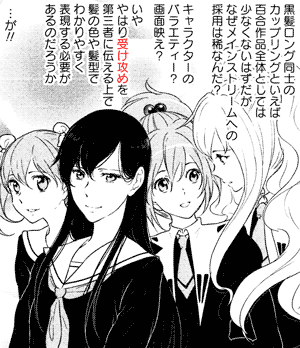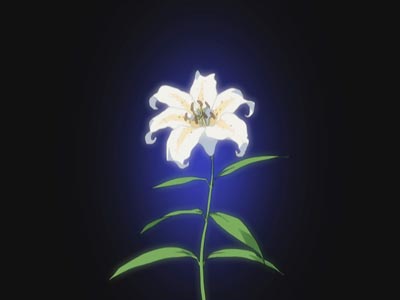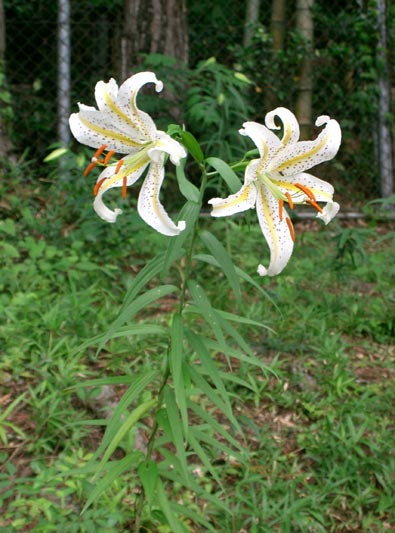In anime, yuri 百合, meaning literally "lily," the flower, refers to lesbian fiction. In Japanese, yuri is lesbian fiction in general. In English yuri is normally lesbian hentai (drawn pornography), its gay counterpart is yaoi. The term originates as a counterpart of bara 薔薇, "rose," another gay genre. Sometimes, Yuri, or Yuuri, is somebody's name instead. It's also spelled ユリ, ゆり.
Right: Himeji Mizuki 姫路瑞希
Anime: Baka to Test to Shoukanjuu バカとテストと召喚獣 (Episode 2, Censored)
Definition
What yuri means in English and in Japanese differs.
Lesbian Genre
In English, lesbian hentai is called yuri, this includes adult anime, manga, fanfiction, and so on, while non-pornographic anime focusing on a lesbian romantic relationship is called shoujo-ai instead.
In Japanese, yuri refers to lesbian scenarios in general, while and shoujo-ai 少女愛, literally "girls' love," is a term for "pedophilia" instead, as in "liking (little) girls."
In English, there is a shoujo-ai vs. yuri dichotomy, but in Japanese shoujo-ai isn't a genre, and everything relating lesbian romance is just called yuri.
This difference can catch people off guard sometimes.
- Yuru Yuri ゆるゆり is a series about Cute Girls Doing Cute Things, but if you only know the term yuri as being about lesbian pornography, you'll imagine it's about something completely different.
A guy that likes yuri is called a hime-danshi 姫男子, "princess boy," or yuri-danshi 百合男子.(dic.pixiv.net:姫男子)
See also: fujoshi 腐女子.
vs. Lesbian
The word yuri doesn't mean "lesbian" in Japanese. It only means a lesbian genre of anime, of manga, of light novels, etc. And it also means "lesbian" in the sense of fictional characters being lesbian. For reference, some ways to say "lesbian" in Japanese:
- yuri kankei
百合関係
Lesbian relationship. (of characters in anime, etc.) - bian
ビアン
"Bian." A lesbian person in Real Life™. - rezubian
レスビアン
Lesbian. - rezu
レズ
"Les."- This term is considered offensive by some, while bian is preferred, even though they're both parts of the same word. In particular, rezu-mono レズ物, "les thing," refers to something of the lesbian genre, e.g. pornography.
- {josei no} dou-sei-ai-sha
同性愛者
{Female} "same-sex-love-person."
Homosexual woman. Lesbian.
In English, too, sometimes lesbian scenarios in anime are called yuri, even if they don't feature anything explicit, just situations where a girl looks like she likes another girl. This would also include works categorized as a shoujo-ai.
Origin
The origin of yuri as a word for lesbian is a certain gay magazine called bara-zoku 薔薇族, "rose tribe," which had a lesbian column called yuri-zoku no heya 百合族の部屋 "lily tribe's room."(news.nicovideo.jp)
According to its editor, he wanted to register it as bara, "rose," because "in Greek mythology [...] gay men exchange vows under roses," but the bara was already registered. The reason why the lily flower was chosen for lesbian is:
- yuri wa hora, narushishizumu no shouchou dakara.
百合はほら、ナルシシズムの象徴だから
Because lily is, [you see], the symbol of narcissism.
Note that this was a magazine targeted at gay men (and lesbian women) in real life, so it had nothing to do with anime. It just happens that gay manga that targeted gay men became called bara, while the lesbian ones became called yuri.
vs. Yaoi
In English, the gay counterpart of yuri is yaoi, which might make you wonder why it's not bara, instead.
Basically, bara is a genre that targets gay men, while yaoi typically targets straight women, who ship male anime characters with other male characters, the fujoshi 腐女子. It boils down to there being more straight women into gay shipping than gay men into manga.
vs. GL
Sometimes, yuri is called GL instead. GL stands for "Girls' Love." This is a Japanese term for lesbian fiction, a counterpart for BL, which stands for "Boys' Love." It's uncertain if there is any difference between yuri and GL at all.
Some say they're synonymous. Some say GL is yuri for men. Some say GL is a subset of yuri focusing on romance between underage characters. Some say it's only lighthearted moe 萌え rather than anything serious. Some say it's the same thing as BL, but with girls.(yuri-gl.com)
It's likely GL was just made up as a counterpart for BL. There's in fact a whole series of these terms: BL, GL, NL, ML, TL. Love is pretty standardized nowadays, eh.
See the article on BL for details.
エス
Another term that existed a hundred years ago was Esu エス, the katakanization of the letter "S," from "sister," or "sisterhood." It was a genre dealing with high school girls falling in love with other high school girls.(yuri-gl.com)
Seme & Uke
The terms seme and uke 攻め, 受け refer to the "top" and "bottom" of a gay ship, or the active (assertive) and receptive (passive) roles of any ship in general, including yuri, girl × girl ships.
- Context: a yuri shipper analyzes how seme-uke roles are conveyed through stereotypes.
- {{{kuro-kami-rongu-doushi no} kappuringu to ieba} yuri sakuhin zentai toshite wa sukunakunai} hazu da ga naze meinsutoriimu e no saiyou wa mare nanda?
黒髪ロング同士のカップリングといえば百合作品全体としては少なくないはずだがなぜメインストリームへの採用は稀なんだ?
[I] guess {[considering] all yuri works, {pairings [in which] {both [girls] have long, black hair}} aren't few}, so why [its] use in mainstream [works] is rare?- i.e. a lesbian couple with two characters of long, black hair happens sometimes, but in mainstream works that rarely happens.
- kyarakutaa no baraethii? gamen-bae?
キャラクターのバラエティー?画面映え?
Character variety? [To look good] appearing on screen? - iya, yahari {{uke-seme wo dai-san-sha ni tsutaeru} ue de kami no iro ya kami-gata de wakari-yasuku hyougen suru} hitsuyou ga aru no darou ka
いや やはり受け攻めを第三者に伝える上で髪の色や髪型でわかりやすく表現する必要があるのだろうか
No, [considering it again], [I] guess [it] is because {{to convey who is uke and who is seme to a third-party}, [it] is necessary {to express [it] in a way that's easy to understand, using the hair color, hairstyle, [and so on]}}. - ...ga!!
・・・が!!
...however!!- He then goes on to say that such pairing is great nonetheless.
As a standard, the order of the names in a pairing, or coupling, カップリング, also called a CP, matters: the first name of a CP is the seme and the second is the uke.
Tachi & Neko
Sometimes, the tachi タチ and neko ネコ may be used instead of seme and uke to describe characters' roles in a ship.
Femslash
In English, a femslash is a term for a a lesbian fanfic.(fanlore.org)
There's no specific way to say "femslash" in Japanese. You could say, however:
- yuri no shousetsu
百合の小説
A lesbian story. A lesbian novel. - yuri no esu-esu
百合のSS
A lesbian short-story. - {niji-sousaku no} yuri
二次創作の百合
A lesbian [work] [that] {is a derivative work}.- A "fanfic" that actually uses characters from another author, a parody, rather than having original characters and being made by an author who is merely a fan of anime in general.
With Male Characters
Sometimes, yuri is used to refer to a heterosexual or gay scenario instead of a lesbian one, in which a character is a boy that looks like a girl, i.e. a "trap," in Japanese: an otokonoko 男の娘 character.
- giji-yuri
擬似百合(yuri-gl.com)
Pseudo-yuri. A scenario that looks like yuri, but isn't, possibly featuring:- josou
女装
A girl is actually a guy wearing "female clothes," i.e. crossdressing.- Note: a girl crossdressing is said to be wearing "male clothes," dansou 男装. Since the term used was specifically josou, then dansou still counts as normal yuri.
- futanari
ふたなり
A girl is actually a "hermaphrodite," with this term typically having penis, breasts, and possibly a vagina. - seitenkan
性転換
A girl is actually a guy that "changed sex" and became a girl (or vice-versa), in this case we're talking about nyotaika 女体化 / nantaika 男体化 fiction, in which characters turn into the opposite sex by often magical and sci-fi means, and typically unwillingly, too, rather than a normal trans person. - Stories featuring a non-human species, such that all the males disappeared for some reason, and there are only females left. The cited article cites Simoun シムーン as example, in which everybody is born female and can choose sex at age 17.
- josou
- homo-yuri
ホモ百合(dic.pixiv.net)
Gay yuri. An uke × uke pairing, i.e. a gay ship in which both male characters are bottoms.
Lily Flower
Normally, yuri 百合 means "lily," the flower, or a bunch of "lilies," in the plural.
- Context: a lily.
For reference, a photo of a lily:
- Context: a yama-yuri 山百合, "mountain lily," also known by the scientific name Lilium auratum.
Kanji
- hyaku
百
Hundred. - au
合う
To match. To combine.
Combined together: one hundred matches, or one hundred combinations. This doesn't seem to have anything to do with lilies, so it's impossible to guess the meaning of the word from its kanji.
This happens because 百合 is an ateji 当て字.
According to horticulturist Kuniyoshi Jun 国吉純, lily is written 百合 because of its shape:(news.goo.ne.jp)
- {hyaku-mai hodo no} rinpen ga awasatte-iru
百枚ほどの鱗片が合わさっている
{Around a hundred scales} (petals) are combined together.
- awasaru
合わさる
To be put together.
- awasaru
The readings of 百 and 合 can't form yu-ri. You can read them as hyaku-gou 百合 in on'yomi, but not as yuri. This happens because yuri is a jukujikun 熟字訓, a reading that's only used when a specific combination of kanji is used to spell a word, and not used when those kanji spell other words.
In other words, there was a Japanese word, yuri, that referred to the flower, and 百合 were chosen as the kanji to spell this word because of their meaning.
The origin of yuri ゆり is from the movement of the flower.(news.goo.ne.jp)
- yuri wa {{hosoi} kuki ni {ooki-na} hana wo sakaseru} node {{kaze wo ukete} yureru} sugata ga "yusuri" to nari, {sore ga henka shite} "yuri" to natta.
百合は細い茎に大きな花を咲かせるので風を受けて揺れる姿が『揺すり』となり、それが変化して『ゆり』となった
A lily {makes bloom a {large} flower on a {thin} stalk}, so [its] appearance [when] {[it] wavers {receiving wind}} is called "swinging", {[the pronunciation of that] changed}, becoming "yuri."
Background Effect
In anime, sometimes lilies are used as background effect when there's some yuri (lesbian) action going on, specially when it's someone having a "fantasy," mousou 妄想, shipping a girl they know with another. Such scenarios are often nothing more than obvious yuri fanservice.
Right: Kotoura Haruka 琴浦春香
Anime: Kotoura-san 琴浦さん (Episode 5, Censored)
- Context: two girls doing something lewd.
Person's Name
Sometimes, Yuri is somebody's name instead. Sometimes, Yuri is actually Yuuri, because Yuuri has a long vowel in the Yuu syllable that's also romanized with a macron above the u: Yūri, but nobody knows how to type the macron, so it ends up becoming Yuri without macron.
Notably, Yūri ユーリ!!! on Ice is ironically a series about gay romance that has two called characters Yuuri:
- Katsuki Yuuri 勝生勇利.
- Yuri Plisetsky, katakanized Yuuri Purisetsukii ユーリ・プリセツキー.
References
- 「いま気にかかっているのは少年愛のこと」ゲイ雑誌『薔薇族』の初代編集長 - news.nicovideo.jp, accessed 2021-05-26.
- 「百合」はなぜ、「百」に「合」という漢字なのか? 意外と知らない「花の名前」の由来をリサーチ - news.goo.ne.jp, accessed 2021-05-27.
- エス - yuri-gl.com, accessed 2021-05-27.
- 擬似百合 - yuri-gl.com, accessed 2021-05-27.
- 百合とGLの違い...!? - yuri-gl.com, accessed 2021-05-27.
- ホモ百合 - dic.pixiv.net, accessed 2021-05-27.
- 姫男子 - dic.pixiv.net, accessed 2021-06-04.
- Femslash-fanlore.org, accessed 2021-05-27.





" Fans of manga and anime, specially of the shoujo genre, will sometimes fantasize about female characters of a given series somehow falling in love with each other. Such practice is called "shipping."
ReplyDeleteI would argue that shojo anime (beside magical girls and MariMite) is not the best way to develop femslash. I've read many 80's and 90's shojo.
80’s shoujo manga had a major strike against it when it came to nurturing yuri the same way shounen manga nurtured BL. Not a lot of shoujo manga are about female relationships of any sort! In 80’s shoujo manga, it’s usually a heroine, her love interest, and/or a rival that are the main players. Guys might find a heroine cute–say Ranze from Tokimeki Tonight but it’s slim pickings when it comes to positive f/f interaction. In Saint Seiya you have guys crying and dying for one another. In 80’s shoujo, you have girls that start off at one another’s throats over a guy and slowly come to a tentative friendship. Even magical girl shows, which have become such a fertile playing ground for yuri fans, were mostly a solo operation back in the 80’s.
Current shojo anime? Dude, good luck find more shojo like Sabagebu, and not reverse harem.
If anything, shonen/seinen anime full of cute girls like Tohou, Love live, Madoka Magica, and Kemono Friends is the one where most femslash can be found. You're much more likely to find Madoka/Homura fanarts in pixiv rather than Haruka/Michiru.